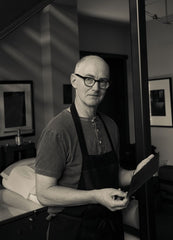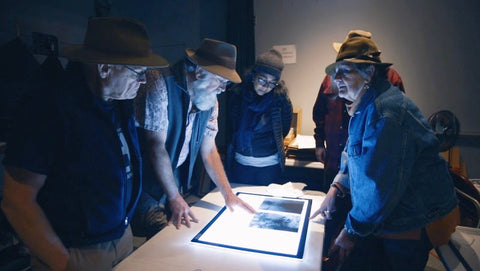





Modern Photogravure Printing
Instructor: Clay Harmon
2025 Dates: October 22 - 25
Focus: Darkroom
Medium: Digital
Designed for the curious, this workshop will take you on a journey through the photogravure printing process, enabling you, the Artist, to produce continuous-tone photographic images using ink and paper. Explore plate-making, inking, wiping and printing techniques, and return home with a complete body of work: 8-12 etched plates and numerous editioned prints from each plate.
Overview
This class is an introduction to the polymer photogravure process, a non-toxic alternative to the traditional copperplate photogravure process. This intaglio printing process enables the artist to produce continuous-tone photographic images using ink and paper. Platemaking, inking, wiping and printing techniques will be covered in this class and the student will leave with 8-12 etched plates and numerous prints from each plate.
FALL 2025 - October 22 - 25
Workshop Details
| Modern Photogravure Printing | |
|---|---|
| INSTRUCTOR | Clay Harmon |
| FOCUS | Darkroom |
| MEDIUM | Digital |
| LEVEL | Beginner to Intermediate |
| ATTENDEES | 6 |
| TUITION | $1300 |
| MATERIAL FEE | $150 |
New for this year’s class, we will be emphasizing direct-to-plate methods for producing polymer photogravure plates. This method uses an inkjet printer to print a positive image directly on the plate that then acts as a light resist. This plate is subsequently exposed with UV light and etched in a water bath. It is a considerably simpler technique and has fewer equipment requirements than the traditional two-exposure method.
After the plate is made, a world of possibilities is now available to make a print. Unlike many alternative processes, a photogravure print is not confined to a narrow set of papers on which to print. Because photogravure is a mechanical rather than a chemical process, the only requirement is that the paper is durable enough to withstand the pressures of the etching press used to transfer ink from the plate to the paper. Both European and Asian papers in weights from tissue-thin to cardboard-thick can be used to make a print. Similarly, the print color is completely at the artistic discretion of the photographer. Virtually any ink color is possible.
The printmaking step is where we will delve into the world of intaglio printing. The basic techniques of inking, wiping and printing a plate will be taught. Paper preparation, press adjustment and edition planning are an integral part of the learning experience in this class. Advanced techniques such as chine collé, in which the printed image is printed on a gossamer-thin gampi paper and simultaneously glued to a thicker support paper will also be covered.
The length of the class will allow the student the opportunity to make a small editioned portfolio of prints and is an ideal opportunity to unify a small body of work with several sets of a series of prints. Photographers interested in exploring a new printing process will learn all the basic techniques necessary to return to their own studio and begin making prints using this process.
About the Instructor

CLAY HARMON Ever since Clay Harmon first viewed a platinum print, he has been creating his art in platinum/palladium and a host of other 19th century photographic print processes such as gum bichromate, cyanotype, and van dyke brown. Somewhere along this fifteen-year journey, he began getting ink under his fingernails and dove headfirst into mastering the photogravure process.
While never one to walk away from taking a pretty landscape picture in the northern latitudes, his favorite subject matter is the quirky world of parking garages, nighttime urban scenes and freeway overpasses, with the occasional statue’s butt, cathedral interior and offbeat portrait thrown in the mix. He enjoys sharing his knowledge and has taught alternative process workshops for the Penland School of Crafts, Asheville Bookworks, Cullowhee Mountain Arts, the Houston Center for Photography, the Museum of Fine Arts Houston, the Kalamazoo Institute of Art, and Project Basho in Philadelphia.
He is represented by the Blue Spiral Gallery in Asheville North Carolina, and has exhibited work at Fotofest in Houston, Rayko Gallery in San Francisco, Houston Center for Photography, and the Clear Lake Arts Alliance. His work is in the permanent collection at the Museum of Fine Arts Houston, and in private collections in the Americas, Europe and the Far East.
Workshop FAQ
Find answers to your questions about our Photography Workshops in our FAQ. Please do not hesitate to reach out if you need additional help. You can reach us by email at photoed@anseladams.com or by phone (650) 692-3495.
Clothing / Dressing for the Elements
Physical Limitations Statement
This workshop may involve some walking and hiking around uneven, hilly, and rocky locations that may present a challenge to some attendees. The gallery workshop team requests your individual judgment to abstain from workshop activities that may be beyond your capabilities.
Although the workshop instructors will try to accommodate all attendees, please be advised that the gallery relies on your abstinence should you feel that a site location may not be safe for you.
Cancellation Policy
The Ansel Adams Gallery Multiple Day Workshop Cancellation Policy: We rely on your confirmed attendance to make important arrangements for the workshop. If you need to cancel, please inform a gallery representative in writing no fewer than 60 days prior to the first day of your scheduled workshop for a partial refund of your tuition that reflects the 10% non-refundable administration charge. Refunds cannot be made for cancellations initiated within 60 days of the first day of the scheduled workshop, or for no-shows, for any reason.
If you are concerned with the possibility of cancellation, please consider purchasing travel insurance.
Workshop registration is NOT transferable.
In the extremely rare event that The Ansel Adams Gallery needs to cancel a workshop, the gallery will refund your full tuition. However, The Ansel Adams Gallery will not be responsible for non-refundable airline tickets, car rentals charges, lodging reservations, or any other expense outside of the workshop tuition.
Lodging reservations made through Yosemite Hospitality - Aramark are fully refundable 14 days in advance of the scheduled first day of check in.
It is recommended not to purchase airline tickets or make non-refundable deposits on lodging that cannot be canceled 14 days prior to the initiation of the workshop event.
The Ansel Adams Gallery highly recommends travel insurance to help with an unfortunate travel event.
This pre-workshop information may be emailed to the education coordinator at photoed@anseladams.com.





